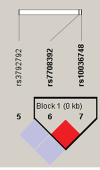Genetic polymorphisms in TNIP1 increase the risk of gastric carcinoma
- PMID: 27250029
- PMCID: PMC5130023
- DOI: 10.18632/oncotarget.9637
Genetic polymorphisms in TNIP1 increase the risk of gastric carcinoma
Abstract
The distribution and levels of TNIP1 in malignant and normal gastric mucosa are different, but it is not known whether TNIP1 polymorphisms are related to gastric carcinogenesis. To assess the association between four TNIP1 SNPs (rs3792792, rs4958881, rs7708392, rs10036748) and carcinogenesis, we used Sequenom Mass-ARRAY technology to determine the genotypes of 302 gastric carcinoma patients and 300 healthy controls in a Northwest Chinese Han population. These data were then compared using the Chi-square test/Fisher's exact test, genetic model analysis, and haplotype analysis. Odds ratios (OR) and 95% confidence intervals (CI) were used to evaluate the correlation. We observed that patients with the "G" allele of rs7708392 and the "C" allele of rs10036748 showed an increased risk of gastric carcinoma (OR= 1.335, 95%CI: 1.021-1.745, P= 0.035; OR= 1.358, 95%CI: 1.039-1.774, P= 0.025, respectively). Conversely, the haplotype "CT" of TNIP1 (rs7708392-rs10036748) may act as a genetic protective factor for gastric carcinoma (adjusted OR= 0.731, 95%CI: 0.552-0.970, P= 0.030). Our results are the first to suggest that genetic variation in TNIP1 gene is associated with gastric carcinoma, though, this finding must be confirmed in other populations with larger sample size.
Keywords: TNF-α-induced protein 3-interacting protein 1 (TNIP1); case-control study; gastric carcinoma; single nucleotide polymorphisms (SNPs).
Conflict of interest statement
The authors have declared that they have no competing financial interests exist.
Figures
References
-
- Ferlay J, Shin HR, Bray F, Forman D, Mathers C, Parkin DM. Estimates of worldwide burden of cancer in 2008: GLOBOCAN 2008. International journal of cancer. 2010;127:2893–2917. - PubMed
-
- Washington K. 7th edition of the AJCC cancer staging manual: stomach. Annals of surgical oncology. 2010;17:3077–3079. - PubMed
-
- Pan Y, Bi F, Liu N, Xue Y, Yao X, Zheng Y, Fan D. Expression of seven main Rho family members in gastric carcinoma. Biochemical and biophysical research communications. 2004;315:686–691. - PubMed
-
- Zebrowska M, Salagacka A, Jelen A, Jesionek-Kupnicka D, Mirowski M, Balcerczak E. Is the ABCB1 gene associated with the increased risk of gastric cancer development?-preliminary research. Pathology, research and practice. 2014;210:872–878. - PubMed
MeSH terms
Substances
LinkOut - more resources
Full Text Sources
Other Literature Sources
Medical
Research Materials


